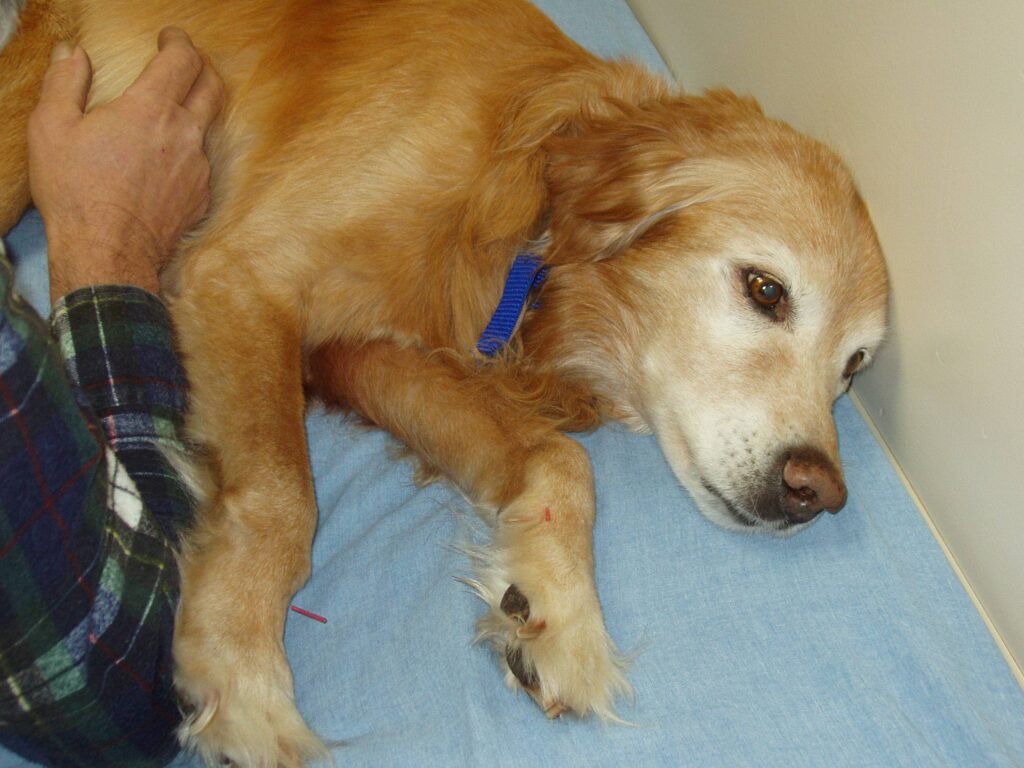Acupuncture is the most widely practiced modality of holistic veterinary medicine. It involves the use of needles which are inserted into specific points on the body in order to affect a cure. In order to understand acupuncture it is necessary to recognize that the ancient Chinese had a much different way of looking at the body than we currently do in the West. For the ancient Chinese, health care was a way of life. Diet, exercise, massage, meditation, sleep patterns, work patterns, herbs and acupuncture were all integrated to maintain balance within the body. At the heart of Traditional Chinese Medicine (TCM) is the concept of Qi (pronounced “chee”).
Qi is regarded as the life force energy. It is what differentiates the living from the dead and has both structural and functional qualities. Qi is that substance from which all physical form is composed. It is also the energy that flows in a cyclic, orderly course throughout the channels of the body allowing for the normal functioning of organs and tissues.
In TCM, health is the state of harmonious flow of Qi and disease is caused by an interruption in this flow. Any time an organ is not functioning properly (as in kidney failure), or a limb is not moving freely (as with arthritis), we say there is a disturbance of Qi.
The Chinese consider the acupuncture points as inlets to the channels. Through these inlets, the flow of Qi can be manipulated and re-balanced, allowing the body to heal itself. Today we know that acupuncture points have unique features. Biopsies have shown that these points have higher than normal numbers of nerve endings, blood vessels, and inflammatory cells. These features combine to amplify the effect of any stimulation of these points.
From the Western standpoint, acupuncture stimulates nerves that can block pain perception. Also, pricking acupuncture points stimulates nerves that send signals to the brain to discharge healing substances. Studies have also shown that acupuncture can be used to cause the release of hormones including cortisone as well as endorphins, which are the body’s own morphine compounds. Acupuncture can also reduce muscle spasms, increase blood circulation, improve athletic performance and strengthen the immune system.
Acupuncture can help in the treatment of any medical condition including arthritis, kidney failure, liver failure, thyroid disease, asthma, back and joint injuries, vomiting, diarrhea, and reproductive problems. It can be used as an adjunct treatment for seizures and can even improve the quality of life for cancer patients. When applied properly, this holistic approach does not cause side effects as drugs often do. Acupuncture can be used alone or in conjunction with conventional therapies.
The biggest apprehension that most people have about acupuncture is that the needles will cause pain. In my experience, the patient rarely objects to the prick of the needles. As a matter of fact, some animals fall asleep during the treatment which may last from five to forty-five minutes depending on the problem being addressed. I’m more concerned about the remote possibility that the pet may decide to remove a needle with his mouth and then swallow it. In reality, the biggest obstacle to an acupuncture treatment is keeping the pet still while the needles work their magic. If the animal fidgets needles may fall out, which is not harmful but just not very helpful.
Acupuncture is not a panacea. Even in China it is only part of the medical system. If after eight to ten weekly treatments there is no improvement in the patient, then acupuncture is probably not going to help. On the other hand, I have many patients who have given it two paws up.
Stoney was 14 years old when he was carried into my office by his owners. His rear legs had been paralyzed for seven weeks and conventional treatments had not helped. X-rays revealed severe arthritis of his spine but that alone did not fully explain his condition. Possible causes for his neurologic deficit included a spinal tumor, a ruptured disc, or even a blood clot to the spinal cord. An MRI or myelogram was needed to be sure of what the problem was, but his owners did not think it was in his best interest to put Stoney through those testes. Acupuncture was his last chance.
An aged pet with long standing rear leg paralysis does not warrant a rosy outlook and I was not optimistic about the ability of acupuncture to help him. After hearing about the acupuncture process and the poor prognosis, Stoney’s owners decided that they wanted to give him every chance they could and we proceeded with the treatment with hope in our hearts.
Stoney came to my office for weekly treatments – right on schedule. When his owners carried him in for his eighth session, I told them that I was seeing no improvement and suggested it was time to admit defeat. On the contrary, his owners were encouraged by the fact that he had begun to wag his tail so the treatments continued. You could have picked my jaw off the floor when Stoney walked into my office two treatments later.
We were able to taper his treatments to every three to four weeks and maintain Stoney’s mobility. He enjoyed another three years with his owners until his body finally gave out and we put him to sleep at the age of 17.



